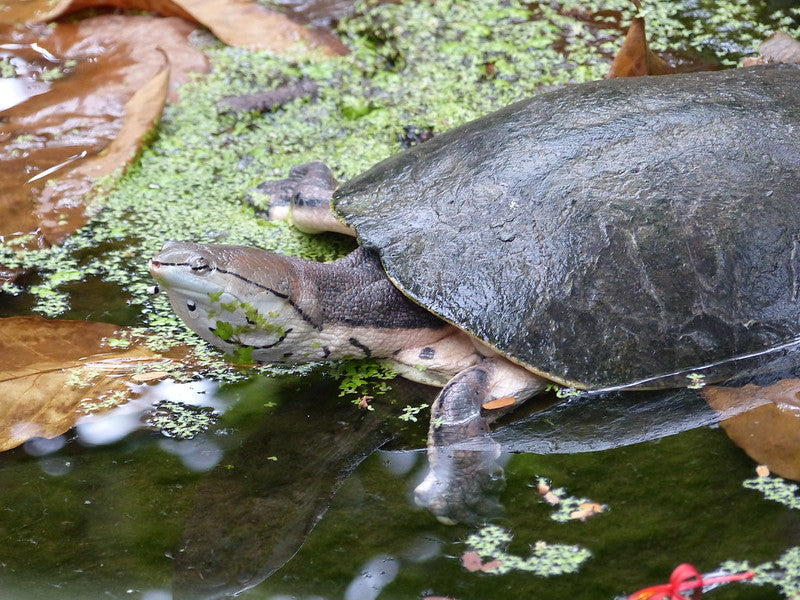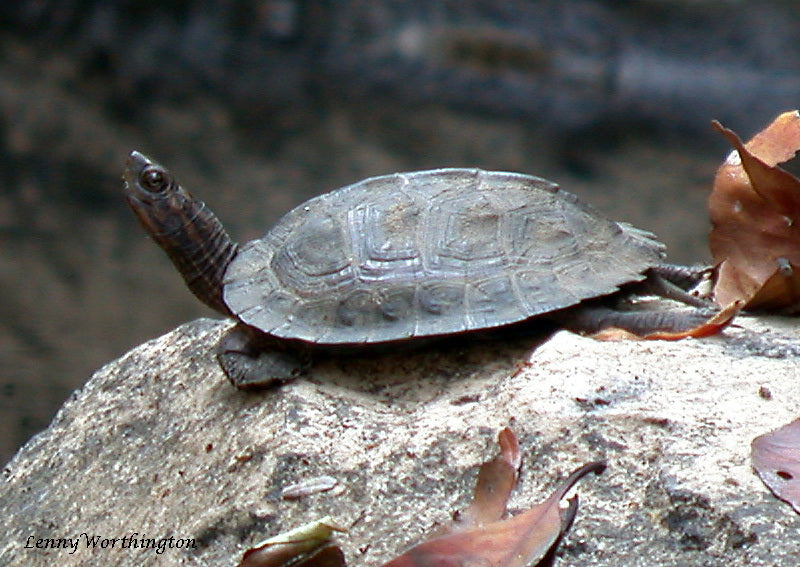The Argentine side-necked turtle (Phrynops hilarii) is also known as Hilaire’s side-necked turtle. They are a large, semi-aquatic, diurnal reptile native to east central South America. They are primarily found in freshwater rivers, but can also be found in swamps, ponds, and lakes with plenty of vegetation.
Argentine side-necked turtles grow up to 16” long. They have a large head, highly pointed snout, flat smooth shell, webbed feet, and two small barbels under the chin. Coloring is gray on top with a pale underside, featuring a black pinstripe on each side of the head extending from the tip of the snout to the shell. The underside is pale and marked with thin black stripes and dots. Each limb also has a black stripe marking the border between gray and white. Each barbel is marked with a black spot.
Argentine side-necked turtles are among the less common pet turtles. Due to their size and husbandry requirements, they are intermediate- to advanced-difficulty pet reptiles.
How much space do Argentine side-necked turtles need?
Argentine side-necked turtles are large and amphibious, and they need an enclosure that will appropriately accommodate their preferred lifestyle. The minimum for appropriately keeping one adult Argentine side-necked turtle is 160 gallons of water. This is just the minimum, and providing a larger pond is both beneficial and appreciated. This species is a strong swimmer, so water depth is not a concern, as long as they have plenty of room to dive!
Argentine side-necked turtles can do very well when housed outdoors where local climate permits, even if it’s just during part of the year (these turtles do not hibernate). This is a convenient way to provide your pet with a generously-sized pond and “free” heating and lighting. If housing your turtle outdoors, make sure that the pond’s depth is at least 1.5x the length of the turtle, and there is a retaining wall around the pond at least 18” tall and buried at least 6” into the ground to prevent potential escape.
It’s best not to house multiple Argentine side-necked turtles in the same enclosure, as they may act aggressively toward other turtles in their “territory.” An exception can be made for particularly large ponds.
Do Argentine side-necked turtles need UVB?
Argentine side-necked turtles require regular exposure to high-quality UVB in order to maintain optimal health and wellbeing. Providing UVB lighting to your turtle gives them all of the vitamin D that their body needs, stimulates better appetite and activity, and strengthens the immune system, as well as other benefits.
The best UVB bulbs for Argentine side-necked turtles are:
- Zoo Med Reptisun T5 HO 5.0
- Arcadia Forest 6%
The UVB bulb should be half the length of the enclosure and housed in a high-quality reflective fixture like the Arcadia ProT5 or Vivarium Electronics. Place the lamp close to the heat lamps, about 12-14” above the basking platform.
It’s also a good idea to provide a strong LED or T5 HO 6500K daylight lamp for additional illumination. This helps better replicate daylight and is also good for any live plants you may be using.
UVB bulbs decay over time, so don’t forget to replace your bulb every 12 months to maintain good performance. If you are housing your turtle outdoors in an appropriate climate, supplementary lighting is not required.
Lights should be on for 14 hours/day during summer and 10 hours/day during winter. Or you can use a smart timer to sync the lights with your local sunrise and sunset times.
What basking temperatures do Argentine side-necked turtles need?
Argentine side-necked turtles are ectotherms, which means that they rely on the variable temperatures of their environment to help regulate their metabolism and stay healthy.
The basking platform should offer high temperatures of 90-95°F, and the water should stay between 72-76°F. Measure basking temperature with a digital probe thermometer, and water temperature with a high-quality aquarium thermometer.
A good way to warm the basking area is with a couple of halogen flood heat lamps clustered on one side of the enclosure and positioned over the basking platform. Do not use ceramic heat emitters (CHEs), red bulbs, or blue bulbs, as these are not as effective. Increase the wattage if they’re too cool, and use a plug-in lamp dimmer if they’re too warm.
If you need to heat the water, use a high-quality aquarium heater rated for at least the maximum volume of water in the enclosure.
If you are housing your turtle outdoors, supplementary heating should not be required. However, Argentine side-necked turtles are a tropical species and do not hibernate, so if your area experiences nighttime winter temperatures of 40°F or lower, they will need to be housed indoors during this time.
How do you maintain the water in an Argentine side-necked turtle pond?
Argentine side-necked turtles are semi-aquatic, which means that most of the enclosure should be water. This water must be kept clean at all times in order to keep your turtle healthy (and to keep the aquarium attractive). The most efficient way to do this is with a combination of excellent filtration and regular water changes.
Aquatic turtles are fairly messy creatures, so you will need a canister-style filter capable of handling at least 2-3x the amount of water in the enclosure. So, for example, if you have an aquarium or pond with 160 gallons of water, you will need a filter rated for at least 320 gallons of water. Don’t settle for the cheapest filter you can find — this is one aspect of your turtle’s enclosure not to skimp on!
Once every 1-2 weeks, remove and replace approximately 30% of the aquarium/pond’s total water volume. This helps minimize buildup of toxic compounds in the water that a filter is unable to resolve. To make the job easier, use a siphon or water pump.
Both indoor and outdoor turtle ponds require filtration and water changes.
Argentine side-necked turtles are also sensitive to the pH of their water. The water in your turtle’s pond should be maintained around 6.0-6.2. To do this, it helps to only use reverse-osmosis (RO) water, which has a naturally lower pH, remineralize with GH+ salt, and test the water weekly with an aquarium pH test kit. Adding a source of tannins to the water such as mopani wood, catappa leaves, alder cones, Indian casuarina cones, or birch cones also helps create and maintain an acidic environment.
What décor can you use in an Argentine side-necked turtle pond?
The most essential piece of “décor” you will need in your turtle’s enclosure is going to be a basking platform. Ideally, this should be a partitioned-off area of land where the turtle can climb out of the water, bask, and explore. If that is not possible, securely stacked rocks, a large piece of wood, or a commercially-available turtle basking platform can be used as a basking location. The turtle should be able to easily climb onto the platform, and be able to remove its entire body from the water.
Aside from the basking area, there are additional ways you can increase the enclosure’s functionality and general attractiveness. Here are some ideas:
- live/artificial plants
- driftwood
- hollow logs
- fine-particle aquatic substrate (ex: sand, silt)
Make sure your turtle has access to places where it can hide from view as needed.
What do Argentine side-necked turtles eat?
Argentine side-necked turtles are primarily insectivorous, which means that they need to eat a diet of mostly insects to get the nutrition that they need. However, they are also known to eat some fish and occasional vegetation.
Protein foods for Argentine side-necked turtles:
- American roaches
- crickets
- earthworms
- dubias
- discoids
- shrimp/krill
- grasshoppers
- snails
- guppies
- mollies
- platies
- mosquito fish
Turtles younger than 1 year old should receive protein food daily, while older turtles should get protein 2-3x/week. Offer as much animal-based food as your turtle will eat in 5-10 minutes. The primary food source should be bugs, with fish being offered more on a treat basis.
Pellets for Argentine side-necked turtles:
- Omega One Juvenile Turtle Pellets
- Omega One Adult Turtle Sticks
- Tetra ReptoMin
- Zoo Med Natural Aquatic Turtle Food
- Mazuri Aquatic Turtle Diet
Turtles younger than 1 year old should receive pellets every other day, while older turtles should get pellets 2-3x/week. A portion of pellets should be roughly the same size as the turtle’s head.
Vegetable foods for Argentine side-necked turtles:
Argentine side-necked turtles eat greens pretty rarely, but it’s good to keep them available so the turtle can graze if desired. The best way to do this is by keeping edible live plants in the enclosure.
- Brazilian waterweed (Egeria densa)
- Canadian pondweed (Elodea candensis)
- Duckweed (Lemnoideae)
- Eelgrass (Vallisneria)
- Water lettuce (Pistia statiotes)
Do Argentine side-necked turtles like to be handled?
As a general rule, turtles do not like to be handled. And Argentine side-necked turtles fit this rule. While they’re not considered particularly bitey, it’s best to keep the handling to a minimum to reduce stress.
If you would like to interact with your turtle, try hand-feeding it with a pair of feeding tongs.
*This care sheet contains only very basic information. Although it’s a good introduction, please do further research with high-quality sources to obtain additional information on caring for this species.
"Helle Krötenkopfschildkröte" by Chriest is licensed under CC BY-NC-SA 2.0.




Leave a comment
This site is protected by hCaptcha and the hCaptcha Privacy Policy and Terms of Service apply.